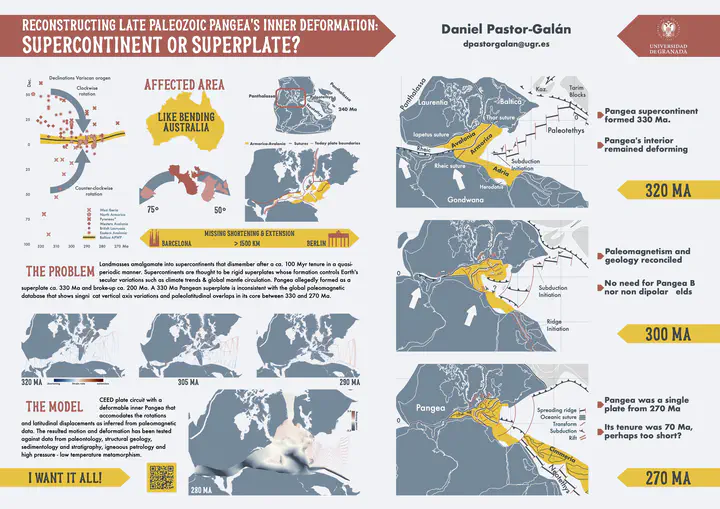Reconstructing Late Paleozoic Pangea's Inner Deformation: Supercontinent or Superplate?
 The Poster
The PosterAbstract
The supercontinent cycle describes landmasses merging into supercontinents, which later disintegrate in a ~100 Myr quasi-periodic manner. Supercontinents, believed to be rigid superplates, influence Earth’s long-term variations, including climate trends and global mantle circulation. Pangea, the latest continental superplate, formed around 330 Ma, rifted at ~240 Ma, and broke apart ~200 Ma, serving as a template for previous supercontinents. However, the existence of Pangea as a superplate at ~330 Ma contradicts: (i) the westward progressively younger continent-continent collision, ending in the early Permian on its westernmost side; (ii) widespread ‘post-orogenic’ magmatism in Pangea’s core and hot high-pressure metamorphism in the Paleotethys; and (iii) the global paleomagnetic database, indicating paleolatitudinal overlaps and significant vertical axis rotations in Pangea’s core between 330 and 270 Ma, suggesting >1500 km of shortening and extension. I present a tectonic reconstruction that includes a deformable inner Pangea that reconciles paleomagnetic and geological discrepancies. In this model, after Pangea’s initial amalgamation, the plates interacted with each other and the asthenosphere during the late Carboniferous and early Permian (320–270 Ma), rather than being rigid. Subsequently, during a plate reorganization, Pangea became a superplate for <70 Myr. This relatively short superplate tenure might be insufficient, as per recent models, to control global mantle circulation. DPG is funded by a Grant PID2021-128801NA-I00 funded by MCIN/AEI/10.13039/501100011033, a Ramón y Cajal Fellow RYC2019-028244-I funded by MCIN/AEI/ 10.13039/501100011033 and by the “European Social Fund Investing in your future”, and a Leonardo grant 2022 to researchers and cultural creators (LEO22-2-3010) from the bank BBVA.